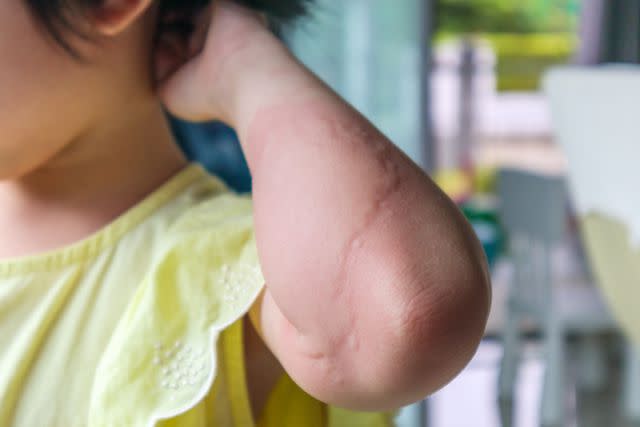Rash That Moves or Spreads to Other Body Parts
Probably Caused by Hives
Medically reviewed by Marisa Garshick, MD
If a rash seems to move around your body, it is likely hives.
Hives, medically known as urticaria, are a common rash that can be triggered by many different substances. Hives come and go, with some people experiencing them moving from one part of the body to the next.
This article will discuss hive symptoms and treatment. It will also cover when to contact a healthcare provider.

Kwangmoozaa / Getty Images
Hives: A Rash That Moves Around
Hives are an itchy, red rash that can be slightly raised off of the skin. It is caused when the immune system sees a threat and releases histamine from mast cells and basophils in the dermis of the skin. The released histamine causes dilation of the blood vessels and fluid to leak into the skin. This results in redness and swelling.
Differences Between Welts and Hives
Welts and hives are the two terms that are often used interchangeably but have slightly different meanings. A welt is a red, raised area of the skin that occurs from an injury or as an immune reaction. Hives are made up of welts. Hives are red, itchy welts that are always an immune reaction.
Triggers
Triggers are substances that cause hives. There are several hive triggers, and someone may develop different triggers or always have the same ones throughout their lifetime. Triggers are either related to allergies or have no relation to allergies. Hives not related to allergies are more common.
Hives that are not related to allergies include:
Hot and cold temperatures
Infections (bacterial and viral)
Exercise
Skin pressure
Emotional stress
Sunlight or tanning beds
Hives that are related to allergies include:
Medications
Food (especially eggs, nuts, peanuts, and shellfish)
Insect bites or stings
Pet dander
Appearance and Sensation
Hives can form on any area of the body at any age. Someone may have one small welt about 1–2 centimeters, or the affected area can be larger, with many welts covering entire areas of their body. Hives can also move around. They may start in one spot, disappear, and then reappear in another area.
Hives can be accompanied by angioedema, which is swelling of the deeper tissues and may feel warm and painful. When this occurs anywhere in the mouth or throat, it can make it difficult to breathe, and is a medical emergency, call 911 immediately.
Here are all the symptoms that may be experienced with hives:
Light to bright red in color
Raised welts
Itchy
Red
Warm
Blanch (turn white) when pressed
Other Rashes That Look Like Hives
Hives are often mistaken for other types of rashes. The redness and itching are common symptoms with many rashes. Rashes that share similar characteristics to hives:
How to Keep a Hives Rash From Spreading
To keep hives from spreading it is important to identify and avoid any known triggers. This can prevent future occurrences as well.
Avoid using aspirin, alcohol, and nonsteroidal anti-inflammatory drugs (NSAIDs), which can worsen symptoms, and should not be used when someone has hives. Also do not scratch hives, as this can make symptoms worse.
Antihistamines
Antihistamines are used to block the histamine response and are very useful in treating hives. Over-the-counter medications like Claritin (loratadine) and Zyrtec (cetirizine) are typically nonsedating (not producing sleepinees) when used at prescribed doses.
Benadryl (diphenhydramine) is another antihistamine that can be used for hives, however, it does carry some side effects like drowsiness, which may not be tolerated by some people.
Topical Treatments
Two types of topical creams can help treat hives. The first are anti-itch lotions, which may include ingredients like calamine, menthol, camphor, and pramoxine. These can help soothe itchiness caused by hives.
The second type of topical cream is hydrocortisone cream. This is a steroid-based cream that reduces swelling and itching.
A cold compress is a nondrug option to reduce the itchiness and swelling from hives. Ice cubes wrapped in a washcloth can provide some relief.
Steroid Medications
For severe cases of hives, a healthcare provider may prescribe an oral steroid medication called prednisone or prednisolone to reduce hive inflammation and itchiness.
These medications need to be taken as directed, and they should not be stopped without first consulting a healthcare provider.
Light Therapy
Phototherapy, also known as light therapy, can be an effective treatment if someone is not responding to other treatments. It is typically done in a healthcare provider's office a few times per week for several months.
When to Consult a Healthcare Provider
Hives are generally self-limiting and resolve on their own or with simple home treatments. However, for some people hives can become chronic. Hives that appear every day or almost every day for six weeks or longer are considered chronic hives. If you have chronic hives, contact your healthcare provider for treatment guidance.
Takeaway
Call 911 immediately if hives are accompanied by difficulty breathing or swelling of the tongue or lips. This may be an anaphylactic reaction and is a life-threatening emergency.
Summary
Hives are a type of rash that causes red, itchy welts. They may come and go, and move around the body. For many people, treatment can be done at home with over-the-counter medications and creams. More severe cases need to be seen by a healthcare provider.
Read the original article on Verywell Health.

